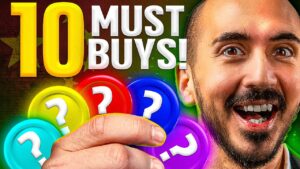Remember Wonder Bread? One squeeze proves we're the
fresh guys. Ooh. For balanced nutrition. Mom chose soft, delicious
Wonder Bread. You'll be glad you did. While, it may not be the
American staple that it once Was. It still generates
nearly half a billion a year In sales. Wonder Bread's
parent company is Flowers Foods, the second largest
individual bread producer in The US. Even to be able to
ask the question what Happened to Wonder Bread
presumes a particular Position in society. Because for a lot of folks,
Wonder Bread has always been There. Today, healthier
alternatives and artisan Breads of all kinds
dominate the very fragmented Bread production industry,
with more than 34,000 Domestic producers and an
estimated value of nearly $53 billion in 2023. While white bread is a
small piece of the entire Industry, Wonder Bread has
steadily grown under Flowers, foods and remains
a solid contributor to its Total portfolio. In fact, from January 2023
to mid-August of 2023, the Company sold about 55
million loaves of Wonder Bread. When a brand has
been around for a long time, The default assumption from
consumers is this brand has To have a certain level of
quality, otherwise it Wouldn't be around for a
hundred years. And so what you see is in
Wonder's sales, and since Flowers added them to the
portfolio, they've gradually Increased as a percentage
of their contribution to Flowers overall portfolio. We believe that
premiumization is a long Term durable trend, but
core white bread will, in
Our view, will never cease
to exist. In 1921, the Taggart Baking
Company announced the Arrival of its Wonder
Bread. Just days prior, Consumers had been teased
by mysterious newspaper Advertisements hinting at
its much anticipated debut. The wonder of seeing hot
air balloons float through The sky at the Indianapolis
Speedway. International balloon race
inspired the brand's logo. Wonder Bread's popularity
greatly increased in the 1930 as Pre-sliced bread
became all the rage. Factory made white bread
like wonder quickly became Touted as clean, pure and
abundant. The attitudes toward it
reflected the views of the Time period. In those days,
one of the biggest selling Points for industrial bread
wasn't that it tasted great Or that it was like
homemade, but rather it was. The number one slogan of
the day was untouched by Human hands. And
underpinning that were a lot Of turmoil around nativism
and fear of immigrants, Primarily the ones running
small bakeries at the time. In the first half of the
20th century, Americans got As much as 30% of their
daily calorie intake from Bread, primarily white
bread. That's because it played an
important role in many American households. It was
easy, convenient and Enriched with vitamins. As television became more
mainstream, kids watched TV While eating their wonder
Bread sandwiches. To grow up good and strong, you ask mom to get Wonder Bread. However, the
counterculture movement in The 1960s perceived
industrial white bread as Corporate and bland. Whole wheat, on the other
hand, went against the grain In the 1970s.
The FTC went after Wonder
Bread for its popular Slogan. Serve Wonder Bread. Wonder helps build strong
bodies 12 ways. The government said that
the 12 ways were an Overstatement, and only
eight elements could in fact Support the claim. Wonder
Bread was trying to Capitalize on this
association of bread eating With strength and vitality. In the postwar period and
in that moment, they went a Little too far. But it was
something that, you know, Many different companies
were doing at that time. Between 1967 and 1982,
white bread consumption Dropped 30% as consumers
began to prioritize health And wellness. Manufacturers
turned to producing whole Wheat bread at mass scale
over the following decade. This once symbol of the
counterculture became a real Piece of change in the
American diet. It was no longer about kind
of a collective revolt Against society. It was about doing this
thing for yourself, you Know, being healthy,
showing a certain class Consciousness by eating a
particular kind of bread That marks you with a
higher class. Despite it all, white bread
didn't immediately fall out Of favor, especially for
blue collar Americans. In 1984, Wonder Bread
produced about 800 million Loaves of bread. Since the
start of 2023 through Mid-August, Flowers Foods
has sold a fraction of that And about 67 million loaves
of its more nutritious Counterpart, Dave's Killer
Bread. After a series of
acquisitions up until 1995, The Wonder Bread brand
eventually became part of Interstate bakeries. In 2004, the company filed
for bankruptcy just five
Years later. Hostess Brands
was formed by a group of Private equity firms that
stepped in to rescue the Company. Hostess' six bread
brands generated just under $1 billion in sales in
2012. Wonder Bread accounted for
about half of that, but Persistent troubles
surrounding labor contract Agreements and increasing
amounts of debt led to a Second bankruptcy in 2012. Wonder Bread was taken off
the market and auctioned off To Flowers Foods in 2013. Hostess It found a buyer
price tag $360 Million. The deal is still subject
to approval by a bankruptcy Court. Flowers Foods
reintroduced Wonder Bread to The market in 2013. Over the course of a
decade, it has rebuilt the Brand back to its
pre-acquisition sales of Nearly $500 million. Sales of Dave's Killer
Bread and Nature's Own, the Two largest brands under
the company umbrella were Both substantially higher
than Wonder Bread in 2022. We're talking, you know,
fresh bread here. So it's not a category that
grows 10% on a normal year. So it's a mature category
typically, broadly speaking, Across kind of CPG world. If you can get a brand that
grows, you know, 2 to 3% Mean inflation plus kind of
population growth, that Usually means you're in a
good spot. The US bread production
industry is dominated by two Major producers Grupo Bimbo
and Flowers Foods. None of the remaining
34,000 producers control Even 1% of the market. Barriers to entry are low. You only need some simple
branding and a good recipe. And Americans seem to enjoy
the variety.
It's the transition from
this kind of period of mass Produced, one size fits all
commodities that reigned During the postwar period,
a period of of declining Economic inequality, strong
unions, manufacturing power Into the kind of the
present day moment where you See the rise of choice and
niche markets. But that's also paralleling
the skyrocketing of economic Inequality in the country. While Wonder Bread may not
have huge sales growth Potential in an
increasingly health Conscious world, it still
sells enough to its core Audience. The company
boasts a 94% brand Awareness. As a company,
you don't want to neglect Those consumers that are
aging but still represent a Large portion of fresh
bread consumers. And so you keep the brand
equity that you have with Wonder and you capitalize
on that group, but then you Also pivot the portfolio
towards kind of the next Generation. I think that's
what you see them doing with Dave's Killer Bread. Dave's
Killer Bread was acquired by Flowers in 2015. In 2018, estimated sales
were $377 million. By 2022, that number had
grown to nearly a billion. 2016 until now, it's
basically grown, you know, 10X. So rapid growth in
comparison to Wonder Bread? Absolutely. And rapid
growth compared to the Category as a whole. The inherent margin benefit
of selling one loaf of Dave's is at nearly twice
the price is substantial Versus selling a single
loaf of Wonder. Flowers has dipped its hand
in a number of different Food markets through
acquisitions of canned Foods, snacks and frozen
vegetable companies.
However, it later divested
from these brands and began To focus solely on the
fresh baked goods category In 2003. Two decades later, Flowers
lineup continues to capture All corners of the market. And Wonder Bread, while
having been through a lot, Doesn't seem to be going
anywhere. Having a kind of a full
gambit of options for Consumers to choose from
with Wonder with Nature's Own. With Dave's Killer
Bread is going to be Important for them to kind
of capitalize and win across All the different consumer
age ranges.





